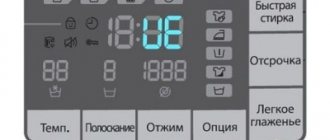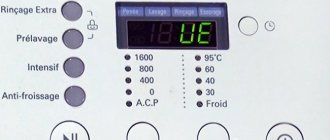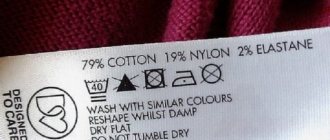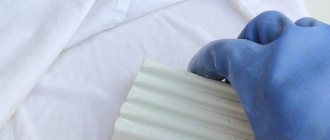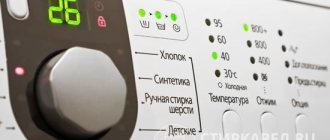Share on social media networks:
For some, buying clothes is a favorite and exciting activity that gradually turns into a mania, for others it is a necessity. But the fact remains that we buy new things all the time and expect them to last for a long time. But it often happens that after washing, the thing you just bought turns into a faded rug, and also a miniature one. Why is this happening? Clothes will last a long time if you care for them properly, wash and iron them at the right temperature. Many of us, having bought a new item, cut off all the tags and labels from it, but they contain all the necessary information that will help your new wardrobe item live happily ever after. Let's figure out what the crossed out triangle on clothes and other symbols on tags mean, and is it necessary to pay such close attention to them?
Marking and everything about it
Typically the first piece of information we look at is size. As a rule, height comes first, then chest girth, and finally hip girth.
Important! There is no single standard - as a rule, each manufacturer has its own size charts.
The manufacturer also applies special symbols, such as a triangle crossed out on clothing, onto a small piece of fabric on the back of the product. Information about the rules of use and how to care for a piece of clothing is very important, and you need to know what this or that marking indicates, for example, what a triangle on a clothing tag or a crossed out triangle or crossed out circle means.
Let's look at all the types of symbols that can be found on textile labels.
The role of icons on clothing labels
The labels contain instructions on how to care for clothes and text in the manufacturer's language. It is not necessary to decipher hieroglyphs, but understanding special signs (basins, circles, crosses) is extremely important!
The signs on clothing labels are deciphered in order to protect the fabric from damage or wear. They inform the owner about the temperature and type of washing, spin modes and drying of items made from a particular fabric.
Wash
The icon in the form of a basin with water will tell us exactly how to wash this or that item. It may contain dots or specific numbers, and under it there may be lines:
- The image of a basin with water and the inscription “machine washable” tells us that this item can be washed in a washing machine.
- Image of a basin with water and one horizontal line - you can wash it, but carefully, without spinning or squeezing.
- An image of a basin with water and two horizontal lines - the item requires the most gentle hand wash without spinning or rubbing.
- The image of a crossed out basin indicates that washing cannot be done at all.
- The image of a basin with water and numbers from 30 to 90 indicates permission to wash at a certain temperature, which, in fact, is indicated.
- The image of a basin with water and a hand inside means that you need to wash it by hand.
Most common definitions
All definitions for advice on caring for things can be divided into several blocks:
- Washing (washing icon on clothes in the form of a schematically depicted basin with water);
- Drying (in a square shape);
- Ironing (in the form of a schematically depicted iron);
- Bleaching ( triangle
); - Professional cleaning (circle).
Other options for depicting icons on clothing labels are also possible, for example, in certain countries, for advice on care, a schematic drawing in the form of a washing machine (a vertical rectangle with a control panel section) and a digital temperature value are used.
Whitening can be depicted as a flask, but the above options are considered the most popular. These five icons on clothing labels are used in any case, if you see a couple more rows, it means that similar information is given in the form of symbols of other systems adopted in various states.
Auxiliary symbols are also used for explanations.
An underscore in the form of one line suggests a sensitive mode, in the form of two dashes - a very sensitive one, i.e. if polite washing is provided, the washing icon on the clothes will be highlighted with one or two lines. A cross through means a prohibition.
Whitening or stain removal
Many of you have probably wondered what the triangle on a clothing tag means. The triangle is one of the bleaching symbols, which shows what type of bleaching can be applied to this item. Sometimes it is decorated with inscriptions, and sometimes the triangle on the clothes is crossed out.
Let's take a closer look at the possible options, so:
- The triangle on the tag indicates that the item can be bleached.
- A triangle with the inscription inside GL - you can use chlorine bleaches.
- Triangle with stripes - only oxygen bleaches can be used.
Important! A crossed out triangle on clothing means that bleaching with any bleach is strictly prohibited.
Ironing
This group of symbols displays ironing methods, the main one being the iron pattern. Additions may be as follows:
- Iron on label - this item can be ironed.
- An iron with one, two or three points shows at what temperature you can iron: one point - at 110 degrees, two points - at 150 degrees, three points - at 200 degrees.
- An iron with a steam symbol crossed out below indicates that the item cannot be steamed.
Important! A crossed out iron is a sign that ironing is prohibited at all.
Ironing notices
The signs are distinguished by the use of dots within the image of an iron.
| Iron without additional elements: the product can stretch. |
| Iron + 1 point: maximum ironing temperature 110 ° C, preferably without steam. |
| Iron + 2 points: maximum temperature 150°C. |
| Iron + 3 points: maximum temperature 200°C. |
| You can't iron |
Dry cleaning
A dry cleaning regimen is another common way to care for your wardrobe items. It is designated by a circle with different symbols inside it.
Frequent markings:
- Circle - dry cleaning possible.
- The letter A in a circle means that any dry cleaning is acceptable.
- Letter P in a circle - dry cleaning using hydrocarbons, chlorethylene, as well as solvent-based cleaners is allowed.
- The letter P in the underlined circle indicates that gentle dry cleaning using ethylene chloride, monofluorotrichloromethane, or hydrocarbon is acceptable.
- The letter F in a circle allows dry cleaning using a hydrocarbon, monofluorotrichloromethane, but the use of solvent-based cleaners is strictly prohibited.
- The letter W in a circle means wet dry cleaning is possible without restrictions.
- The letter W in a circle, underlined by one line, allows only delicate dry cleaning with reduced mechanical impact.
- The letter W in a circle, underlined by one large and one small line, indicates a very delicate dry cleaning with minimal mechanical impact.
Important! A crossed out circle is a sign that dry cleaning is generally unacceptable.
Dry Cleaning Notices
The following symbols are specific to dry cleaning and can be used together to provide more complete information.
| Crossed out circle: dry cleaning prohibited. |
| Circle without additional elements: dry cleaning using any solvents is allowed. |
| Circle + line below: gentle cleaning due to the possibility of shrinkage. |
| Circle + A: cleaning using absolutely any substances. |
| Circle + F: cleaning using petroleum products and trifluoroethane. |
| Circle + P: Clean using perchlorethylene, chlorinated solvents and mineral spirits. |
| Like "Circle + P", but with special precautions. |
Symbols regarding bleaching
| Crossed out triangle: no bleaching |
| Triangle without additional elements: whitening with any bleaching substances is allowed |
| Triangle + Cl: bleaching with chlorine-containing substances is allowed. |
Spin and dry
The next group of signs is dedicated to spinning and describes its features; the main sign is a circle inscribed in a square:
- A circle in a square without any additions - the item can be safely wrung out without fear that it will lose its appearance.
- A circle in a square with a horizontal line at the bottom - only manual or delicate processing during spinning is permissible.
- A circle in a square with two horizontal lines at the bottom indicates gentle hand spinning only.
- A circle in a square with one dot in the center allows machine drying at low temperatures.
- A circle in a square with two dots in the center allows you to sew this item at medium temperature, that is, in normal drying mode.
Important! A crossed out circle in a square means that this item cannot be dried or squeezed.
Decoding the icons on clothes: machine washable or not
Depending on the manufacturer, clothing care labels may vary. But their meaning is always the same: they inform the user about proper care so that the item does not wear out longer. The labels are sewn onto the seams from the wrong side.
How to figure out what the symbols on your clothes mean? The table below provides a detailed breakdown.
Wash
Typically, the sign indicating the washing mode is indicated first. Having deciphered it, you will understand how to wash the item correctly: in a machine or by hand to avoid premature wear. You can see such washing mode icons on children's and adult clothing.
Handwash. Products made from fabrics that require careful care are washed on low temperature cycles, no higher than 40 degrees. Washing by hand should be done carefully, without strong impact and wringing.
Whitening icons
The second symbol on the tag after washing explains how to bleach. To avoid spoiling things, do not ignore these symbols.
| Icon (symbol) | Meaning |
| The triangle symbol indicates that bleaching is acceptable if necessary. | |
| "Do not bleach" sign. A crossed out triangle means it is prohibited to bleach, especially with chlorine-containing substances. | |
| Clothes can be bleached. In this case, the process should not occur at high temperatures; complete dissolution of the powder is mandatory. | |
| Black triangle with parallel stripes – bleaching is allowed without chlorine. |
Icons showing how to dry things
Next in order is an icon indicating how to properly dry the product: in a vertical position, spread on the surface or in the drum of the machine (if such a function is available).
| Symbol | What does it mean |
| The square on the tag allows you to dry clothes using any of the known methods. | |
| If you find such a designation on the label of your clothes, refuse to dry them at all. | |
| The vertical stripe in the square schematically explains that it is best to ensure vertical drying. | |
| In this case, it is also recommended to dry things vertically, but avoid squeezing - the water should drain freely. | |
| A horizontal stripe in a square means that things are recommended to be flattened on a surface: a table or ironing board (this way they will retain their size and shape). | |
| Similar to the vertical drying sign. With this symbol, it is forbidden to wring things out and it is recommended to dry them spread out on a horizontal surface. | |
| A square with a vertical stripe and a line in the corner does not prohibit vertical drying. You just need to protect things from exposure to direct sunlight (the ideal place is in the fresh air or on the balcony, in the shade). | |
| Drying takes place without spinning in a vertical position. Requires protection from sunlight. | |
| A square with a horizontal line and a stripe in the corner indicates horizontal drying of the item. In addition, it is worth protecting clothes from sun exposure. | |
| One of the most demanding symbols, prohibiting spinning, hanging (dry only in a horizontal plane) and exposure to direct sunlight. | |
| Today this symbol is almost never used. Indicates vertical drying of laundry. | |
| The product cannot be dried in the washing machine. | |
| Over-drying the laundry is not allowed, so the maximum drying temperature is 60 degrees. | |
| Dry safely at temperatures up to 80 degrees. | |
| This icon does not recommend squeezing or wringing water out of items to preserve their aesthetics and shape. | |
| Another symbol for hang drying. |
Ironing icons
In order to know what the permissible ironing temperature is for different fabrics, an icon with the ironing temperature is indicated on the label.
| Legend | Meaning |
| The maximum temperature mark is 140 degrees. | |
| The sign quite logically informs that the product cannot be ironed. | |
| You will find it on products made of nylon, nylon, polyester, and synthetics. Ironing at 110 degrees through a lining (gauze, thin fabric) is recommended. | |
| For delicate natural fabrics - silk, viscose, cotton, etc. Expert opinion Zakharov Igor Vyacheslavovich Consultant at a furniture store. 5 years of experience. – suitable for 150-degree ironing mode. | |
| Ironing at temperatures up to 200°C. Suitable for linen and cotton items. |
Dry cleaning
When a product needs dry cleaning, be sure to look at the label to see if it can be cleaned and under what circumstances.

